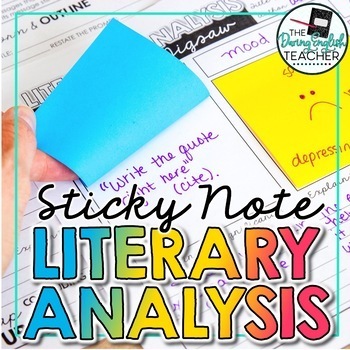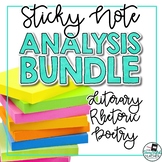Literary Analysis with Sticky Notes - Short Story Unit w/ Activities, Writing
- Zip
What educators are saying
Also included in
- Engage your students all year long with analysis sticky note units. You and your students will analyze literature, rhetoric and nonfiction, and poetry.This bundle includes:Literary Analysis with Sticky Notes: Activities, Writing, and PowerPointRhetorical Analysis Unit with Sticky Notes: Activities,Price $47.99Original Price $68.00Save $20.01
- This bundle includes the print sticky note literary analysis teaching unit and the new digital version as well.Digitally engage your students in a literary analysis activity! Increase student engagement and understanding in your next literary analysis unit with digital close reading organizers and sPrice $13.00Original Price $18.00Save $5.00
Description
Teaching literary analysis can be fun, engaging, and accessible for all students! Increase student engagement and understanding in your next literary analysis unit (whether it be short stories or novels) with interactive and hands-on close reading organizers and scaffolded writing responses. Students will enjoy using sticky notes in class as they analyze the author's use of various literary devices in complex short stories and novels.
This is a complete literature unit in itself!
This sticky note literary analysis unit is a great way to help students learn to thoroughly analyze literature. By focusing on just one or two devices at a time, students are better able to understand how the device is used and why it is effective!
This lesson includes:
- an editable, 25-slide PowerPoint for teaching literary devices and short stories
- 17 interactive literary device organizers
- 13 writing prompts with outlines
- 2 grading rubrics
- teacher instructions
- a sample week lesson plan
- suggested stories and paired literary devices
- group brainstorming ideas
Literary Devices Included:
- figurative language
- setting
- characterization
- conflict
- symbolism
- motif
- theme
- point-of-view
- mood
- tone
- hero's journey
This unit includes almost all of the resources you will need for a complete literary analysis unit. You will need to choose and provide the text you read in class to make your own unit come to life. With a little prep work and all of the materials in this unit, you will teach the best short story unit, literary analysis unit, or novel study ever!







